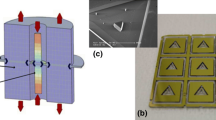Abstract—
This paper examines mechanisms responsible for internal friction in the surface layer of fused quartz, which degrades the performance of high-Q mechanical resonators. We propose a combined process for surface treatment of such resonators, which includes asymptotic mechanical treatment, chemical removal of a surface glass zone, and secondary annealing for stress relieve in the material. Data are presented that demonstrate adequacy of this approach. The proposed process allows one to fabricate fused quartz mechanical resonators with a quality factor of 107 and above.





Similar content being viewed by others
REFERENCES
Braginsky, V.G., Bilenko, I.A., Vyatchanin, M.L., Gorodetsky, M.L., Mitrofanov, V.P., Prokhorov, L.G., Strygin, S.E., and Khalili, F.Ya., The road to the discovery of gravitational waves, Phys.-Usp., 2016, vol. 186, no. 9, pp. 879–885.https://doi.org/10.3367/UFNr.2016.03.037811
Klimov, D.M., Zhuravlev, V.F., and Zhbanov, Yu.K., Kvartsevyi polusfericheskii rezonator (volnovoi tverdotel’nyi giroskop) (Hemispherical Quartz Resonator (Solid-State Wave Gyroscope)), Moscow: Kim L.A., 2017.
Gotz, J., Brouseni a Lesteni Skla, Praha: Statni Nakladatelstvi Technicke Literatury, 1963.
Obeid, A., Dynamics of surface roughness formation during polishing with free abrasives, Cand. Sci. (Eng.) Dissertation, St. Petersburg: St. Petersburg National Research Univ. of Information Technologies, Mechanics, and Optics, 2005.
Piskarev, P.V., Improving the quality of diamond abrasive polishing of glass by using effective synthetic lubricant–coolant technological fluids, Cand. Sci. (Eng.) Dissertation, Ivanovo: Ivanovo State Univ., 2004.
Lipatova, A.B., Improving the throughput performance and quality of polishing of crystallographically oriented plates with diamond wheels, Cand. Sci. (Eng.) Dissertation, Moscow State Technological Univ. Stankin, 2008.
Miller, P.E., Suratwala, T.I., Wong, L.L., Feit, M.D., Menapace, J.A., Davis, P.J., and Steele, R.A., The distribution of subsurface damage in fused silica, Proc. SPIE, Laser-Induced Damage in Optical Materials, 2005, vol. 5991, paper 599101.https://doi.org/10.1117/12.638821
Lambropoulos, J.C., From abrasive size to subsurface damage in grinding, in OSA Technical Digest, 2000, pp. 17–18.https://doi.org/10.1364/OFT.2000.OMA6
Panasyuk, G.P., Kozerozhets, I.V., Voroshilov, I.L., Ivakin, Yu.D., Privalov, V.I., and Danchevskaya, M.N., Water forms on the surface and in the bulk of silicon dioxide, Russ. J. Inorg. Chem., 2021, vol. 66, no. 5, pp. 724–730.https://doi.org/10.1134/S0036023621050120
Smagin, A.G., Sound absorption phenomenon in the surface layer of crystals, Vopr. Radioelektron. Detali Komponenty Apparatury, 1964, no. 11, pp. 65–69.
Darinskii, B.M., Izmailov, N.V., Loginov, V.A., Mitrokhin, V.I., and Yaroslavtsev, N.P., Surface damage-related inelastic relaxation in solids, Fiz. Tverd. Tela (S.-Peterburg), 1987, vol. 29, no. 12, pp. 3529–3533.
Lunin, B.S. and Torbin, S.N., Effect of stress on internal friction in silica glass, Vestn. Mosk. Gos. Univ., Ser. 2: Khim., 2003, vol. 44, no. 2, pp. 108–114.
Spierings, G.A., Review: wet etching of silicate glasses in hydrofluoric acid based solutions, J. Mater. Sci., 1993, vol. 28, pp. 6261–6273.https://doi.org/10.1007/BF01352182
Cook, L.M., Chemical processes in glass polishing, J. Non-Cryst. Solids, 1990, vol. 120, nos. 1–3, pp. 152–171.https://doi.org/10.1016/0022-3093(90)90200-6
Lunin, B.S. and Tokmakov, K.V., Reduction in internal friction in silica glass with high OH content, J. Am. Ceram. Soc., 2019, vol. 102, no. 6, pp. 3329–3340.https://doi.org/10.1111/jace.16187
Zener, C., Internal friction in solids: I. Theory of internal friction in reeds, Phys. Rev., 1937, vol. 52, no. 3, pp. 230–235.
Startin, W.J., Beilby, M.A., and Saulson, P.R., Mechanical quality factors of fused silica resonators, Rev. Sci. Instrum., 1998, vol. 69, no. 10, pp. 3681–3689.https://doi.org/10.1063/1.1149159
Strakna, R.E., Clark, A.E., Bradley, D.L., and Slie, W.M., Effect of fast-neutron irradiation on the pressure and temperature dependence of the elastic moduli of SiO2 glass, J. Appl. Phys., 1963, vol. 34, no. 5, pp. 1439–1443.
Author information
Authors and Affiliations
Corresponding author
Ethics declarations
The authors declare that they have no conflicts of interest.
Additional information
Translated by O. Tsarev
Rights and permissions
About this article
Cite this article
Lunin, B.S., Lopatin, V.M. Surface Internal Friction in High-Q Fused Quartz Resonators. Inorg Mater 58, 636–642 (2022). https://doi.org/10.1134/S0020168522050077
Received:
Revised:
Accepted:
Published:
Issue Date:
DOI: https://doi.org/10.1134/S0020168522050077




